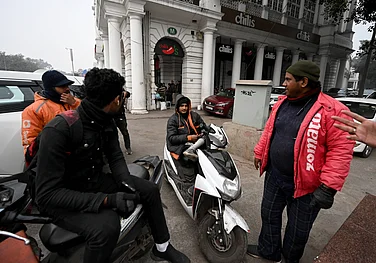The ancients, across cultures, thought seven denoted perfection. Modern psychologists called it “the magical number”. There are seven colours, seven swaras, seven rishis. But in recent Indian political history, the number hasn’t been all that auspicious. The UPA’s stars were in the ascendant till that year of its reign. And now, as the Narendra Modi epoch completes its own seventh, as the regime surveys the darkened landscape all around, and as the pandemic-hit people of India gaze back at it through ash and smoke, we seem to be in the vicinity of a similar cusp. Not that the government saw it coming—perhaps it wasn’t even looking. On March 7, Union health minister Harsh Vardhan declared victory over Covid-19, saying: “We are in the endgame of the pandemic.” He was taking a cue from the narrative the Prime Minister himself had woven. Other arms of the government duly played choristers. ‘Atmanirbhar’ India, in this telling, was saving the world. Everyone bought into that till, less than a month later, the equation was summarily inverted by a tsunami-like second wave. The story of the previous seven years, its highs and lows, its shock and awe, are well known. But here was shock and awe—and unquantifiable grief—on an altogether different scale. Can this be a prism to read the Modi regime’s full tenure? Perhaps, perhaps not. Can this be a crystal ball? Again, answer indeterminate.
ALSO READ: Twice Orphaned
But there’s one thing beyond doubt. The Modi regime’s actual performance graph may be a theme of polarising debates, but there was universal consensus on his capacity to manage perceptions—even create them on a mass-hypnotic scale. The summer of 2021 won’t be kind to that felicity. Not with lakhs of urban and rural Indians gasping for oxygen, hopelessly seeking hospital beds, putting out desperate pleas on social media for life-saving drugs, and bodies piling up at crematoriums and washing up on river banks. Not with the world media peeling off layers of politeness to report the story as it is. The government scrambled to make amends…but it was all too little, too late.
Acutely aware that the narrative is spinning out of control, the BJP has cranked up its publicity machinery by several more notches. In-house articles praising Modi are being amplified by senior leaders and ministers. BJP IT Cell head Amit Malviya bemoaned that only deaths were being reported, not recoveries. Party president J.P.Nadda wrote an open letter to Congress president Sonia Gandhi, accusing her party of creating “false panic”. And the RSS is seeking to lighten the gloom with a ‘Positivity Unlimited’ programme. One imperative in all this is the crucial UP elections early next year. But if you keep that aside, there’s discernible discontent even within the ranks. “If things don’t improve, the BJP may just lose control over UP. Yogi (Adityanath) is no Modi, who still holds some sway over people’s imagination,” warns a senior BJP leader from UP.
ALSO READ: The Empire Of Cruelty
Not many, in fact, even agree with the idea that Modi continues to exude an unbeatable charm. “Ever since 2014, we succeeded in managing perceptions, nobody really asked the tough questions. What happened to ‘Make in India’? Where are the Smart Cities? Where is Digital India? The pandemic has laid bare our decrepit healthcare infrastructure, and also the brittleness of other structures—like the education system, with the future of millions of students shrouded in uncertainty,” says an irate BJP leader, who himself was infected with the coronavirus, along with most of his family. One problem, analysts say, is the overdependence on the PM—casting him as the “saviour” for all seasons. “Can you imagine the education minister cannot even take a call on postponing the CBSE exams? Even for that the PM has to step in,” the leader adds.
ALSO READ: The Complete Covid Chargesheet
Seshadri Chari, former editor of Organiser, says Modi has done well in many fields but has not been able to build a good team in seven years. “What comes across is a one-man army. While real merit is not finding a place in his team, those who are there don’t have the freedom to make decisions. As PM, you have to repose trust in your people,” he tells Outlook. Chari feels many ministries, including finance, have not seen worthy incumbents. “Any intelligent Opposition party would have taken advantage of these lacunae,” he says. The over-reliance on one person, creating a ‘macho image’ for him, also comes in the way of consensus-building—a method that would have been useful during the pandemic. “Our political class sees consensus-building and reaching out to the Opposition as a sign of weakness. This is a flawed way of thinking and not unique to the Modi-led BJP,” he adds. He cites the example of Rajiv Gandhi. “Those were the days when BJP had only two MPs in the Lok Sabha, one being L.K. Advani. Once when Advaniji got up to offer some suggestion in the House, Rajiv Gandhi retorted—‘Hum kis ki baat sunenge, jinke do sadasya hai?’ (shall we listen to a two-seat party?),” Chari explains.
ALSO READ: Jantar Mantar Is Just A Sundial. Period
But the RSS veteran feels Modi still does not have a viable alternative, and that gives him a chance for course correction, something the UPA did not have. When the UPA’s decline started in 2011 with the anti-corruption movement, it never got a chance to recover: the BJP was waiting as a worthy competitor. The reverse doesn’t hold true now, says Chari. Thus, by 2024, he believes the BJP can recover the ground it may have lost in 2021. “But the question is, does the top man have the mindset to do a course correction? That entails putting together a better team with the freedom to take decisions, and reaching out to the opposition,” he says.
Most leaders feel that may be a long shot for someone like Modi. But it’s an unprecedented situation for him. The Covid disaster, twinned with the loss in West Bengal, has caused much damage to Brand Modi. Former Rajya Sabha MP Pavan Varma says the fabled Modi invincibility has been broken, even if not completely shattered. “That he can do no wrong, that he will have popular support come what may, with minimum or no electoral consequences, is now under question. There is immense pent-up anger,” he tells Outlook. Whether this will translate into a terminal decline depends on the nature of the Opposition. “An organised, pan-India Opposition is needed to harness this resentment, to take it to the next level of electoral competence. An Opposition with a real face, a common minimum programme and a coherent ideology is needed to forge a strategic narrative against the government. Photo-ops where Opposition leaders gather are overrated metaphors,” adds Varma, who has also been advisor to Bihar chief minister Nitish Kumar.
ALSO READ: Union Of Federal Uncooperative
He has a word of caution for the Opposition. “In a democracy, one should never underestimate the potential of the government. Three years is a long time for it to change the narrative in its favour. It’s also sufficient time for the Opposition parties to reorganise themselves…then 2024 could be an interesting battle,” he says. Bengal demonstrated the limits of the BJP’s strategy of polarisation for him, but he feels the element of Hindutva—which he prefers to call “the Hindu satya”—has now seeped into India’s electoral soil.
It’s not just polarisation that has started giving diminishing yields for the BJP. Many leaders cite the arrogance that a long tenure in office brings. Former Congress spokesperson Sanjay Jha concedes some amount of “cockiness” had crept into the UPA’s second term too. “The Congress too came into its second term with more seats. Then came hubris and the feeling that nobody can dislodge me,” he says. “But the BJP will definitely try and do something big before 2024. Like the Ram temple,” says Jha, who was suspended from the Congress for his open criticism of the party. He’s not sure if the Congress will be in a position to lead an Opposition charge, but believes the party will continue to be a force. “It’s in head-to-head contests with the BJP in Rajasthan, Madhya Pradesh, Gujarat and Chhattisgarh. In terms of numerical representation, it’s still the only party that can take on the BJP,” he adds.
ALSO READ: ‘Modi Brought India To Its Knees’
Sharmistha Mukherjee, national spokesperson of the Congress, tells Outlook that the Covid second wave may well be the turning point. “It has come at a dear cost. Lakhs have died because of the government’s mismanagement. It will leave a permanent scar on the psyche of the people,” she says. She traces its roots to arrogance, more than complacency. “At such times, the country has to stand together. They should have reached out to the Opposition, engaged with experienced people like Manmohan Singh. Instead, they were busy with elections,” Sharmistha adds.
Right-wing political analyst Anand Ranganathan agrees the government lost focus. “That too, much before the elections. And that had a domino effect. The states aped the Centre and soon everyone became lazy. There’s no doubt that both sides messed up, abdicated their responsibilities and left it to the citizens to fend for themselves,” he says. Ranganathan, a professor at JNU’s Special Centre for Molecular Medicine, also lists a few critical failures on the science side. “We sequenced the Indian mutant back in October. That was the time to do contact tracing, isolate, nip it in the bud. We failed to do that. We ran out of funds to speed up genome sequencing,” he says. Also, the government almost cussedly refused to see the signs. “Most nations experienced a bigger second wave. America faced a catastrophic oxygen scarcity in California in December-January. Couldn’t our health and science task forces foresee a drastic upsurge in oxygen requirement in the second wave?” he asks. Even on vaccination, Ranganathan says India was three months late. “Even now, we are vaccinating only one million a day, first dose. In the past four months, we’ve touched our daily vaccination capacity of 6 million doses only once,” he rues. “The government lost focus much before the assembly elections. In fact, they used the occasion to try and fortify themselves—huge rallies, religious festivals. Who is responsible for the misery and deaths,” he says, vocalising the question everyone wants an answer to. Where does the buck stop?
ALSO READ:


























